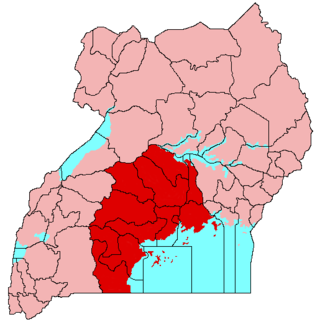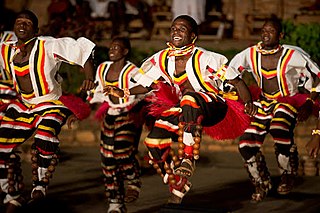
Buganda is a Bantu kingdom within Uganda. The kingdom of the Baganda people, Buganda is the largest of the traditional kingdoms in present-day East Africa, consisting of Uganda's Central Region, including the Ugandan capital Kampala. The 14 million Baganda make up the largest Ugandan region, representing approximately 16% of Uganda's population.

The culture of Indonesia has been shaped by the interplay of indigenous customs and diverse foreign influences. With over 600 distinct ethnic groups, including significant Austronesian and Melanesian cultures, contributing to its rich traditions, languages, and customs, Indonesia is a melting pot of diversity. Positioned along ancient trade routes between the Far East, South Asia, and the Middle East, the country has absorbed cultural practices influenced by Hinduism, Buddhism, Confucianism, Islam, and Christianity. These influences have created a complex cultural tapestry that often differs from the original indigenous cultures.

The music of Qatar is based on sea folk poetry, song and dance. The historical importance of pearl fishing have deeply resonated within the region's artistic expression, manifesting in melodies, tunes, and dances that reflect the enduring bond between humanity and the sea. Traditional dances in Doha are performed on Friday afternoons; one such dance is the Ardah, a stylized martial dance performed by two rows of dancers who are accompanied by an array of percussion instruments, including al-ras, mirwas and cymbals with small drums. Other folk instruments include the oud and rebaba, both string instruments, as well as the ney and sirttai, which are types of flutes.

Culture of Uganda is made up of a diverse range of ethnic groups. Lake Kyoga forms the northern boundary for the Bantu-speaking people, who dominate much of East, Central, and Southern Africa. In Uganda, they include the Baganda and several other tribes

Kabaka is the title of the king of the Kingdom of Buganda. According to the traditions of the Baganda, they are ruled by two kings, one spiritual and the other secular.

African dance refers to the various dance styles of sub-Saharan Africa. These dances are closely connected with the traditional rhythms and music traditions of the region. Music and dancing is an integral part of many traditional African societies. Songs and dances facilitate teaching and promoting social values, celebrating special events and major life milestones, performing oral history and other recitations, and spiritual experiences. African dance uses the concepts of polyrhythm and total body articulation. African dances are a collective activity performed in large groups, with significant interaction between dancers and onlookers in the majority of styles.

The Royal Ballet of Cambodia is a classical Khmer dance known for its intricate hand movements and elaborate costumes. Historically linked to the Khmer court, it has been performed at various royal ceremonies such as coronations, weddings, funerals, and Khmer holidays. The repertoire includes various ancient Khmer legends.

Ngoma are musical instruments used by certain Bantu populations of Africa. Ngoma is derived from the Kongo word for "drum". Different Bantu-inhabited regions have their own traditions of percussion, with different names for their instruments. In Kikongo, "ngoma" is used by extension to signify specific dances, social occasions, and rhythms. In Swahili, Ngoma music is used to describe music, dance, instruments including the drums, and events together as a joint cultural practice.

Folk dances of Assam include the Bihu and the Bagurumba, the Bhortal, the Ojapali dance. Assam is home to many groups: Muslim, Indo-Aryan, Rabha, Bodo, Dimasa, Karbi, Mising, Sonowal Kacharis, Mishmi and Tiwa (Lalung) etc. These cultures come together to create an Assamese culture. Residents of the state of Assam are known as "Axomiya" (Assamese). Most tribes have their own language, although Assamese is the primary language of the state.
Bhangra is a type of traditional folk dance of Punjab area of the Indian subcontinent. According to Manuel (2001), bhangra is especially associated with the vernal Vaisakhi festival, performed during harvest season between April and the first quarter of May.

Bigwala is a genre of ceremonial music and dance of the Busoga Kingdom in Uganda centered around gourd trumpets.

Muchongoyo is a presentational dance and drumming style that emphasizes acrobatic and stomping sequences to dazzle spectators during gatherings or competitions with a complementary rythme of sharp claps. In Zimbabwe, it is the most well-liked Ndau dance. In Zimbabwe's Chipinge, Chimanimani, Chiredzi, and Buhera districts, muchongoyo is a traditional dance that is performed for celebratory purposes or events of cultural significance such as burials of chief and royals. It particularly identifies with the Ndau people, though less strongly identifies with the Tsonga (Shangani) people. Muchongolo is the name of it in Tsonga.

Bwola, also known as Acholi bwola, is a traditional dance that originates from the Acholi people in Northern Uganda. It is reserved for special occasions and performances in front of royalty, including kings and chiefs. This dance is often showcased during the installation of new chiefs or at various royal functions.

Entogoro, also known as Orunyege, is a traditional courtship dance that is performed by the Batooro people of western Uganda. The dance holds great significance in the Tooro culture, practiced by young adults to select potential partners for marriage, as well as during weddings, initiation ceremonies, and social gatherings. Its name comes from the ebinyege rattles and entogoro rings associated with the dance.
Ekizino, also knowns Kizino, is a traditional social dance originating from the Bakiga people in Kigezi region of southwestern Uganda. It is derived from the hilly terrains of the region, where farmers engage in vigorous jumping to warm up and stretch their muscles after a hard day's work.

Orunyege-Ntogoro is a traditional dance from the Bunyoro and Tooro kingdoms in western Uganda. It is a courtship dance that involves the use of rattles (ebinyege) and rings (entogoro) to produce rhythmic sounds and movements. The dance is performed by young men and women who seek to attract and impress potential partners for marriage.

Bakisimba dance (Baakisiimba) also known as Nankasa or Muwogola is a traditional dance form originating from the Baganda people of Buganda Kingdom in Central Uganda. It is believed to have originated from the movements of a drunken King Ssuuna of Buganda Kingdom. The dance was initially performed in the Buganda Royal Court in ancient times an it holds significant cultural and social importance within the community and is often performed during tribal ceremonies, celebrations, and festive occasions.

Dingi dingi dance, also known as Acholi Children's Dance, is a traditional dance originating from the Acholi people of northern Uganda who occupy districts such as Gulu, Kitgum, Lamwo, Pader, and Nwoya. The Acholi have passed down this cultural dance through generations. The name "dingi dingi" derives from the rhythmic sound produced by small drums played by skilled drummers.
Kadodi dance is a traditional dance performed by the Bamasaba people, also known as the Bagisu or the Gishu, who live in the eastern part of Uganda and the western part of Kenya. Kadodi dance is mainly associated with the Imbalu the male circumcision ceremony that marks the transition from boyhood to manhood among the Bamasaba. Kadodi dance is also performed at other occasions, such as weddings, festivals, and cultural events.

Akogo dance is a traditional dance form of the Teso people of Eastern Uganda. This cultural expression is performed by both men and women, who gracefully move their bodies in synchrony with the rhythmic beats of the akogo, a percussion instrument crafted from bamboo tubes of varying lengths. The Dance is believed to have been performed by the Teso people for centuries and has evolved over time and has been influenced by other dance forms from neighboring regions.


















